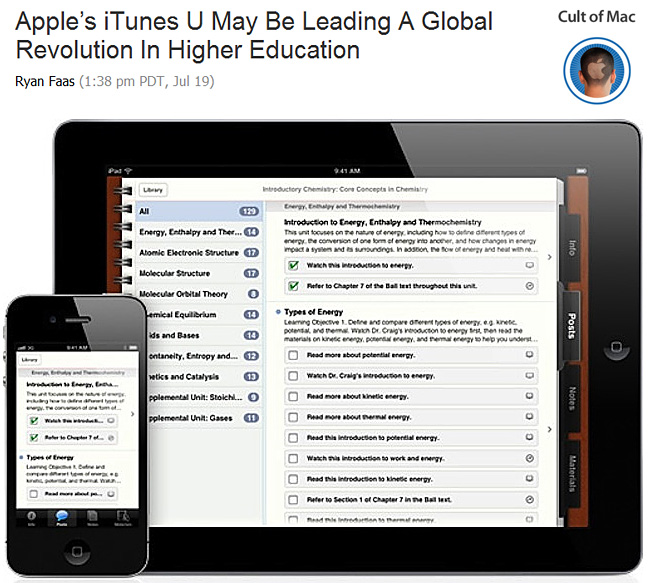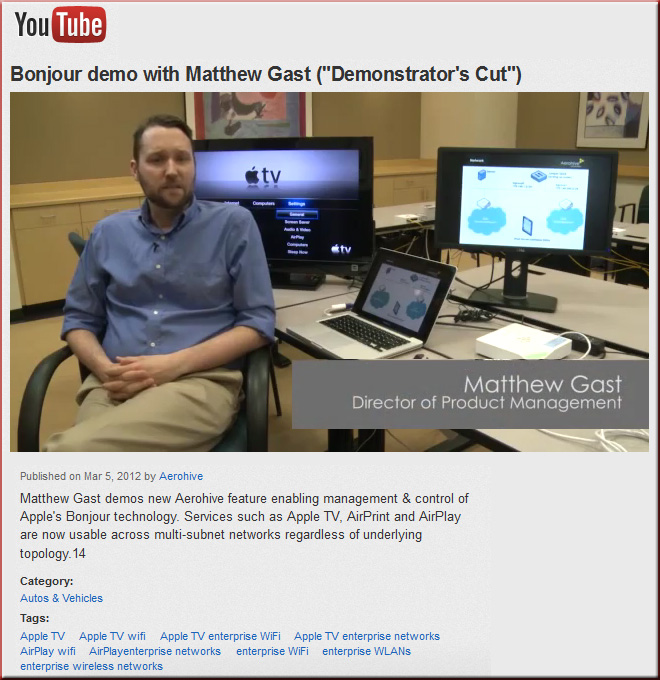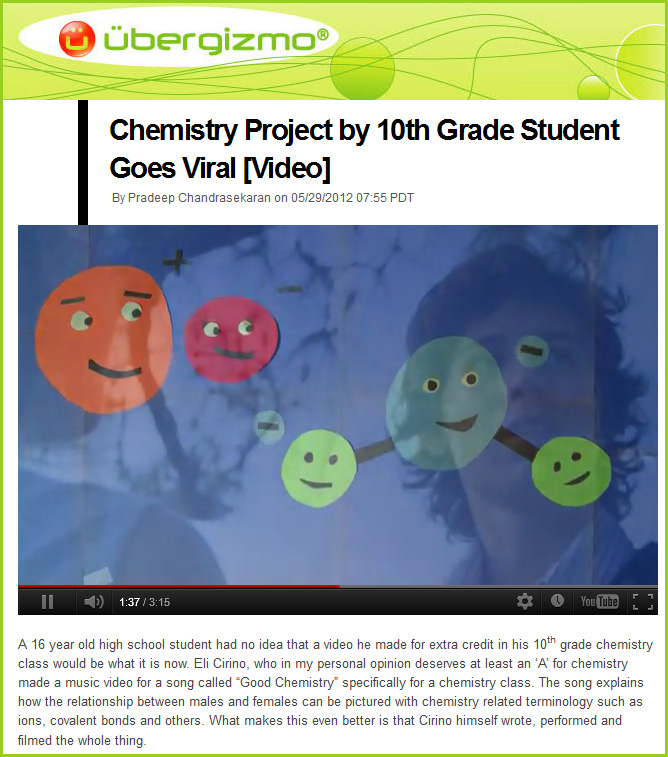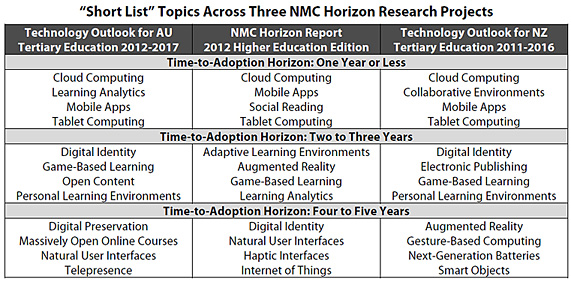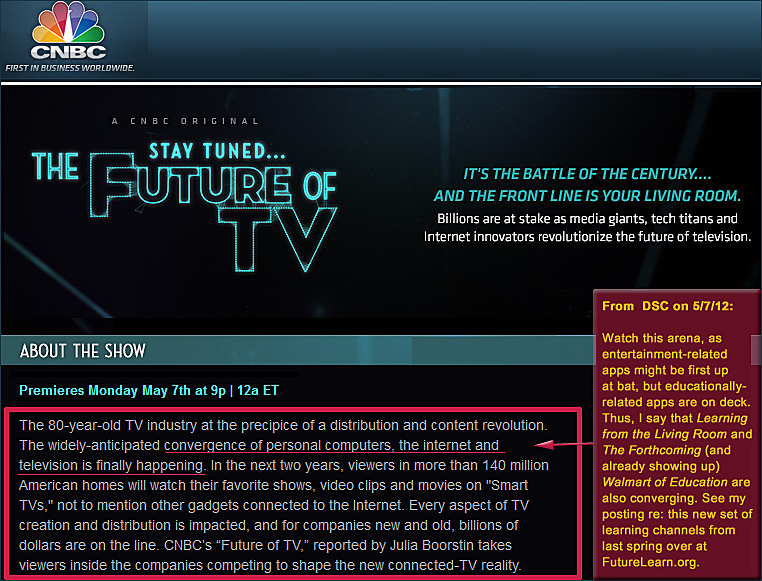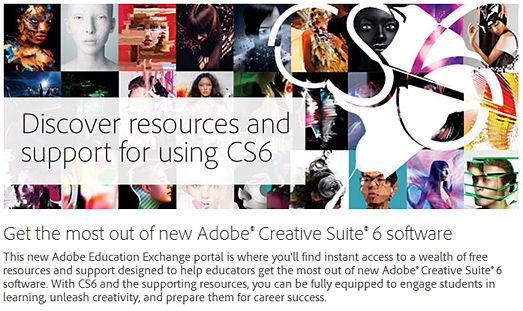From DSC:
Apple has been putting together a solid ecosystem of hardware and software that allows for the creation and distribution of content. “Easy is hard” I like to say and Apple’s done a great job of creating easy-to-use devices and apps. They have a long way to go before iTunes U has all the built-in functionality needed to replace a Blackboard Learn or a Moodle type of CMS/LMS. But given their solid history of creating highly-usable hardware and software, they could deal a smashing blow to what’s happening in the CMS/LMS world today.
Plus, with Apple TV, Airplay mirroring, the growth of second screen-based apps, and machine-to-machine communications, Apple is poised to get into this game…big time. If my thoughts re: “Learning from the Living [Class] Room” come to fruition, Apple would be positioned for some serious worldwide impact on lifelong learning; especially when combined with the developments such as the use of MOOCs, AI and HCI-related innovations, learning agents, web-based learner profiles, and potential/upcoming changes to accreditation.
Too far fetched do you think? Hmmm….well considering that online learning has already been proven to be at least as affective as f2f learning — and in some studies has produced even greater learning outcomes/results — I wonder how things will look in mid-2015…? (That is, where is the innovation occurring?)
Addendum:
- Connected TV penetration to top 50% by 2017 — from worldscreen.com by Mansha Daswani
Excerpt:
SCOTTSDALE: ABI Research forecasts that more than 50 percent of television homes in North America and Western Europe will have Internet-connected TV sets by 2017, up from just 10 percent last year, while Blu-ray player penetration is expected to rise to more than 76 percent from about 25 percent. The report notes that the popularity of connected TV is not limited to developed markets—there have been increasing shipments to China, ABI notes.
. - Advertisers need to pay attention to connected TV [INFOGRAPHIC] — from Mashable.com
. - The future of TV is two screens, one held firmly in your hands — from FastCompany.com by Kit Eaton
Excerpt:
The connected TV, sometimes called the smart TV (and even branded as such by Samsung) is a growing phenomenon: TV makers are adding limited apps, Net connectivity, and even streaming media powers to their newer TVs in the hope they’ll persuade you to upgrade your newish LCD for a flatter, smarter unit. They’re desperate to, given how flat this market is. But according to new research from Pew, the future of TV may actually be a little more closely aligned with the notion of a “connected TV viewer,” an important distinction. Pew spoke to over 2,200 U.S. adults a couple of months ago and discovered that 52% of all adult cell phone owners now “incorporate their mobile devices into their television watching experiences.”
Microsoft buys CNN’s Magic Wall maker — from CNN.com by Erin Kim
Excerpt:
NEW YORK (CNNMoney) — Microsoft is adding a magic touch. Microsoft said Monday that it has agreed to buy Perceptive Pixel Inc., which makes large, multi-touch displays, including CNN’s “Magic Wall.”
CNN’s John King used the Magic Wall for his coverage of the Michigan and Arizona primaries this year.
.
Why Did Microsoft Buy Giant-Touchscreen-Maker Perceptive Pixel?— from readwriteweb.com by Brian Proffitt
From DSC:
I could easily see a “video wall” in the Smart Classrooms of the near future, integrating this technology and more. Intel’s incorporated/captured such a vision as well in this piece here.
I would like to see such a mechanism be able to obtain files from students, check them for any viruses/malware, and then distribute the files to other students (if they choose to receive the files).
From DSC:
I wonder:
- If the video wall pictured above could be a Smart/connected TV and if it can share files as well as play files?
- If such a setup will involve machine-to-machine communications (NFC, other)?
- If it will be like banking setups whereby the student’s device must obtain a constantly rotating password to access a resource that expires in ___ seconds — and they must be in that room to get it?
- If it will be hardware or software based…or both?
Aerohive demos Bonjour Gateway and BYOD on stage at Apple’s WWDC 2012 Conference — from community.spiceworks.com
Excerpt:
What’s the next best thing to being among the anointed few who get to attend Apple’s WWDC 2012? Being on the WWDC stage with Apple, of course!
Aerohive took the stage at WWDC 2012 just moments ago [on 6/12/12) when our very own Vice President of Business Development Bill Hoppin stood alongside Apple’s Stuart Cheshire (father of the Bonjour protocol) and demonstrated our slick new product – Bonjour Gateway.
In a session called Simplify Networking with Bonjour […tying into Aerohive’s theme of Simpli-Fi Enterprise Networking ], Bill showed attendees how Aerohive is offering (bring your own device) BYOD management to help with the explosion of iPhones, iPads and other mobile devices in the workplace.
Here’s how the demo went down…
Also see:
- Breaking Subnet Boundaries with Bonjour: Simplifying Apple TV and AirPlay in the enterprise — from blogs.aerohive.com by Matthew Gast
.
Games for Learning — part of the Games for Change Festival
Excerpt from Jennifer Levine:
For 9 years, the Games for Change Festival has brought the advocacy of social impact games to the industry’s attention. It’s where educators are exposed to new initiatives to bring games for learning to new frontiers. This year, the Festival will devote two entire days focusing on how educators can use the impact of games in formal and informal classroom settings.
Join long time investor in tools for teaching game designer, AMD, as they present an entire track of programming and workshops dedicated to teaching game design in the classroom. And don’t miss the Games for Learning Institute track which highlights research into games-based learning in a series of engaging talks including talks from Constance Steinkuehler, James Paul Gee, and creators of Portal, Valve Software.
Beyond that, there’s a wealth of impressive discussions, roundtables, demos and more at our full program here.
With less than a month left to register for the festival, what are you waiting for? Register now and don’t forget that groups of 5 or more who register together get 25% off! (#G4C12 and/or @G4C on Twitter)
Beyond Smart TV: ‘Surfaces’ prototype reveals the television of tomorrow — from wired.com by Christina Bonnington
Excerpt:
“In a few years’ time, you’ll be able to buy a TV that covers an entire wall, acting like wallpaper,” NDS chief marketing officer Nigel Smith told Wired. In this way, the TV could take the form of a gigantic canvas, providing layers of additional information, as well as different levels of immersion.
Because wall-sized TVs are hard to come by, NDS created a $30,000 setup comprised of six LCDs arranged in a rectangular array. The onscreen system is coded in HTML5 and runs on Chrome. A second screen experience, also coded in HTML5, provides remote control functionality in the browser of an iPad.
Xbox 360 hailed as a game-changer for Connected TV — from v-net.tv by John Moulding
Excerpt:
The Xbox 360 will be a game-changing device in the Connected TV market now that Microsoft has decided to transform it from a games console into a general entertainment hub. That is the view of Christian Bombrun, Deputy General Manager, Web, at M6, the French broadcaster that last December became the first free French channel to be available via a games console. “The difference between the Xbox and connected TVs is that this device is very well connected. Most people that buy a connected TV do not even know they are getting one and they do not plug it into the Internet,” he argues. “Xbox 360 users have already connected the device to enhance the gaming experience.”

The evolving definition of television — from readwriteweb.com by John Paul Titlow
Excerpt:
What will be interesting to watch is what evolves around that big screen – everything from the little screens and the apps they contain to the way that real-time communication and other data from the Web are integrated into the experience.
.

Keynote: Changing the user-experience: How will we watch TV in the future? –– keynote by Stefan Jenzowsky, Head of Multimedia, Siemens CMT — at the Connected TV Summit 2012
Ikea’s Uppleva TV will be a smart TV, have video streaming apps — from SlashGear.com by Mark Raby
.
.
When Smart TV gets smart — from uievolution.com by Pete Schwab, Senior Director, at UIEvolution.
Two-thirds of Americans watch at least one online video per day — from VideoMind.com by Greg Franzese
PANEL: Next steps for Connected TV –– from net.tv
Addendums on 5/17/12:
- Global Market Leader Visiware, Inc. Defines the Next Generation of Social TV
700 Interactive Televised Shows Aired Across 10 Countries Using Visiware’s Second-Screen PlayAlong™
NEW YORK, May 16, 2012 — /PRNewswire/ — Visiware, Inc., a global leader in the interactive television industry, announced today it has reached a milestone of 700 interactive TV shows aired across 10 countries using its second-screen PlayAlong™ product. PlayAlong™ provides TV viewers with the ability to interact real-time from their second-screen devices during their favorite programs. - As multi-screen TV matures, customer experience is key — from v-net.tv by John Moulding
- Ooyala.com
From DSC:
As Brian Crosby points out in the title of his blog — “Learning is Messy.”
There is no silver bullet in the world of education that can be used to effectively teach everyone. In fact, if you were to get 100 instructional designers/teachers/professors/instructors/trainers in the same room, you will not be able to find anything close to a strong agreement on what constitutes the best and most effective learning theory as well as the practical implementations of applying that learning theory (even if we were to be talking about the same age range of students). In my Master’s work, I was looking for that silver bullet…but I never found one.
It is very difficult for a professor or a teacher to deliver truly personalized/customized learning to each student in their classroom:
- How can a teacher consistently know and remember what motivates each particular student?
- Because so much of learning depends upon prior learning, what “hooks” exist — per student — that he/she can use to hang new information on?
- Then, what’s the most effective method of delivering the content for each particular student that might shift the content from their working memories to their long-term memories? (And in the process, do so in a way that develops a love for learning that will serve the student well over his lifetime)
- What’s the best way to assess the learning for each student?
- Which students cognitive loads are being eaten up due to the nervousness around being assessed?
- What are the best methods of passing along those learnings onto the students’ future teachers’ for the students’ benefit?
In my estimation, the way we have things setup throughout most K-16 education, this is an impossible task. When there’s typically only 1-2 teachers trying to teach to 20-30 students at a time, how can this type of personalized instruction occur?
However, I believe digital learning and its surrounding tools/ecosystems hold enormous promise for delivering truly customized/personalized learning opportunities. Such technologies will be able to learn where a student is at, how to motivate them, how fast to push them, and how they best progress through a type of content. Such tools will provide real-time, learning-related, diagnostic dashboards for professors or teachers to leverage in order to guide and optimize a student’s education.
.

.
So I believe that the promise is there for delivering truly customized/personalized learning opportunities available 24x7x365 — even though we aren’t completely there yet. But think of the power a teacher would have if he or she had IBM’s Watson AI-based analysis on each student at their disposal! A “guide on the side” using such diagnostic tools could be a ***potent*** ally for a student.*
As such, I see innovative approaches continuing to come to fruition that will harness the power of serious games, analytics, web-based learner profiles, and multimedia-based/interactive learning content. Eventually, a piece of this type of personalized education will enter in via the Smart/Connected TVs of our living rooms…but that’s a post I’m building out for another day in the near future.
.
*Another hope I have here is that such technologies will
enable students to identify and pursue their passions.
Some items that reinforced this notion for me include:
The key link from Bloom (1913-1999) one e-learning paper you must read plus his taxonomy of learning — an excellent item from Donald Clark Plan B (also see Donald’s archives for postings re: 50 top learning theorists)
The 2 Sigma Problem: The Search for Methods of Group Instruction as Effective as One-to-One Tutoring
Benjamin Bloom
University of Chicago | Northwestern University
Excerpt:
Most striking were the differences in final achievement measures under the three conditions. Using the standard deviation (sigma) or the control (conventional) class, it was typically found that the average student under tutoring was about two standard deviations above the average of the control class (the average tutored student was above 98% of the students in the control class). The average student under mastery learning was about one standard deviation above the average of the control class(the average mastery learning student was above 84% of the students in the control class).
Two key items from EdNet Insight’s Anne Wujcik:
Mapping a Personalized Learning Journey – K-12 Students and Parents Connect the Dots with Digital Learning — from Project Tomorrow
Personalizing Learning in 2012 — The Student & Parent Point of View [infographic] — from Project Tomorrow
Excerpt from Anne’s posting:
This first report focuses on how today’s students are personalizing their own learning, and how their parents are supporting this effort. That personalization centers around three student desires: including how students seek out resources that are digitally-rich, untethered and socially-based. The report share the unfiltered views of K-12 students and parents on these key trends and documents their aspirations for fully leveraging the technologies supporting these trends to transform their learning lives.










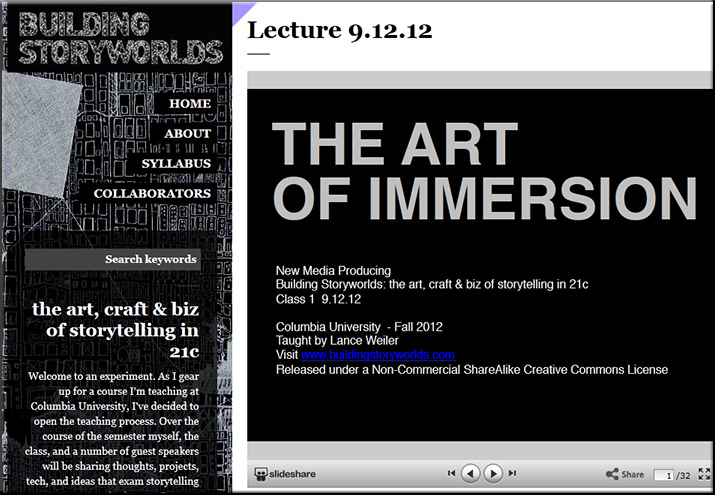




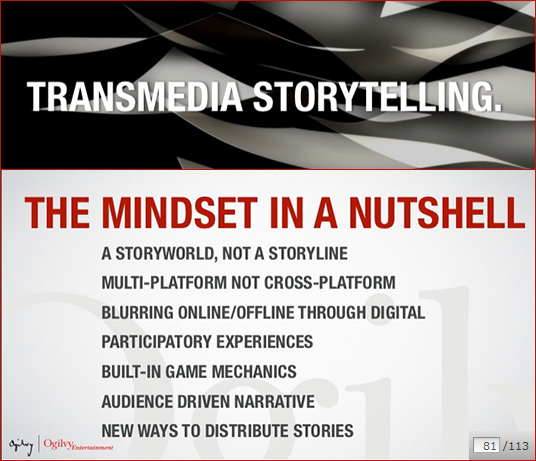
![The-Living-Class-Room-Daniel-S-Christian---July-2012 The Living [Class] Room -- by Daniel Christian -- July 2012 -- a second device used in conjunction with a Smart/Connected TV](http://danielschristian.com/learning-ecosystems/wp-content/uploads/2012/07/The-Living-Class-Room-Daniel-S-Christian-July-2012.jpg)
